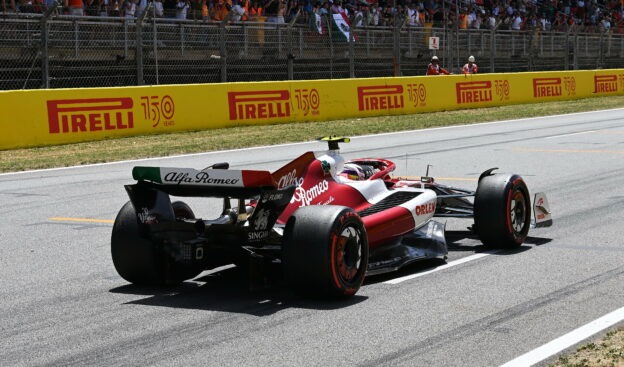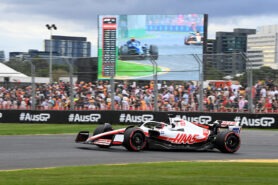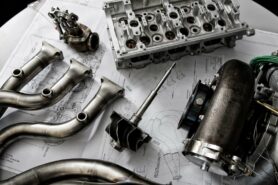F1 is Already Eyeing Up the Next Generation of Cars

May 25 - A lot has changed in F1 since Liberty Media took over the sport in 2017. It has embraced social media, added new venues to the calendar, and experimented with format changes. Formula 1 bosses have also signed new deals with sponsors and partners, including one with AWS to produce more data about what’s happening on track to help fans follow along at home. A similar agreement was also signed to provide more real-time information with sports betting brands. This has meant that bookmakers like 888sport can offer more wagering options to entice F1 fans to their platform, in addition to the free bets and other promotions that they use in their marketing.
2022 brought the biggest raft of changes. It has seen the teams create entirely new cars built with an entirely new philosophy, using the underside of the floor to generate downforce rather than relying solely on the carefully curved bodywork.
The rationale behind the move was to allow cars to travel closer together on the circuits and to make overtaking easier. Partway through the 2022 season, it seems pretty safe to say that the rule changes have achieved their aims as drivers have reported being able to chase cars for longer and attack multiple times without having to worry about their tyres overheating and losing grip.
However, before the new season is through, the sport’s technical personnel and the governing body are working hard to define a new set of regulations that are due to come into force in 2026.
Right now, few details are available about what the changes will be in four years' time, though officials have outlined a set of aspirations that they will work towards as they develop the rulebook for four years time.
New Engines
A big part of Formula 1 is engines. The big blocks of metal that sit in the back of the cars turn carefully crafted recipes of fuel into more than 1,000 bhp, allowing the cars to exceed 200 mph on the straights and to accelerate from zero to 60 in around 2.6 seconds.
Back in 2014, F1 introduced a radical redesign to engine specifications, doing away with the naturally-aspirated V8s that had screamed around circuits for a decade, and replacing them with 1.6 litre turbocharged V6 engines that are paired with two energy recovery systems that charge a battery.
The combination of a turbo and these two recovery systems allowed this (relatively) tiny motor to produce more than 10 times the power you’d find in most road cars.
In 2022, minor revisions to the rules now require teams to fuel their cars with E10 petrol, a mixture of 90% gasoline and 10% ethanol. This is in an attempt to drive towards more sustainability in F1 and there are already plans to require the ethanol to be sourced from waste organic matter in the future.
But the current engines are expensive and the MGU-H, which generates electrical energy from waste heat, is not transferable to road cars. So for 2026, it has been announced that the engines will drop this component in favour of a larger battery and a more powerful MGU-K to recover more energy from braking.
In doing so, F1 bosses hope that it will make the new engines cheaper and lead to the development of technology that will be suitable for use in everyday road cars. The rumours running rampant around the racing world is that these new rules would allow VW Group to enter the sport as an engine supplier and possibly a constructor.
Reducing Drag and Improving Efficiency
The engines will be a major step forward in sustainability for Formula 1, though this isn’t the only area where attempts are being made to make the cars better for the environment.

Kevin Magnussen, Haas VF-22 during qualifying for the Australian GP at Melbourne Grand Prix Circuit on Friday April 09, 2022
Another place of focus in on drag, the phenomenon created by air passing over the car as it travels at high speed. Drag, or wind/air resistance, builds exponentially as the cars speed up, making the effect higher at faster speeds.
Drag increases the amount of force that the car must overcome to travel faster, forcing the engine to burn more fuel to offset it. Reducing drag will make F1 cars reach higher speeds more quickly and allow them to use less fuel in the process. Therefore, they would be more efficient in terms of fuel burned and how quickly they got around the track.
Smaller and Lighter Cars
Reducing the amount of fuel needed will also make the cars lighter, contributing towards another key objective.
Much talk has been had in 2022 about the fact that teams have struggled keeping to the new (and increased) weight limit of F1’s new rules. Increased safety structures added to the cars for this season have meant additional crash structures have been added, coming with a weight penalty. The larger 18-inch wheels are also heavier than the 13-inch versions used last year, a fact that is compounded by the increased weight of the new wheel covers that have been placed over them.
In recent years, cars have been growing larger and larger, especially after the 2017 rule change. But the FIA and F1 want to put a stop to this and hopefully reverse the trend to further reduce fuel use, lower the energy of crashes, and make overtaking easier on narrower tracks.
Improve Safety
The FIA has prioritised safety over everything else for several decades now, and rightly so. In the next raft of changes, it wants to develop new active and connected safety systems.
While little is known about what this could entail, some have speculated it could involve cars being fitted with devices that can be alerted to a slow-moving or stopped vehicles and either warn the driver faster than a yellow flag, or even take automatic evasive action. Similar systems to what is found in road cars like Tesla’s various models, though a lot of work will need to be done to ensure that they’re suitable for vehicles travelling at such high speeds.
All in all, F1 cars should be faster, lighter, more sustainable, and safer in 2026 if Formula One Management and the FIA get their way.
✅ Check out more posts with related topics:













